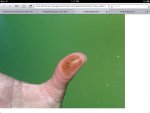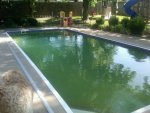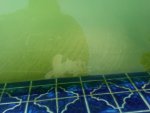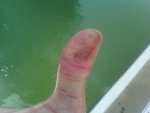Re: Heavily stained fg pool with red/rust scale? (pics attac
A Cautionary Note to The Casual Reader
These instructions are specifically for smhill's pool only and should not be applied to even slightly similar pools or similar situations
smhill's pool particular pool size - 16,800 gallons, pool type - Fiberglass, issues - algae, mineral staining, and chemical balance issues
Experienced pool keepers might gain some benefit from the discussion
Inexperienced pool keepers, sometimes referred to as "Newbies" are advised to seek individual help instructions for their particular situations, by posting to this forum and receiving advise from members who choose to respond.
Thank you, smallpooldad.
-------------------------------------------------------------------------------------------------------------------------------------------------
smhill,
Thank you for doing all those checks. Keep it up with the pictures, they help a lot. It was good to see the algae being slime green, and not the other colors, then probably no iron bacteria.
The following instructions are quite long, but necessary to get it done correctly, and to a "newbie" might be overwhelming. If they are, please feel free to ask questions, and point out to me where I might make it clearer. My old teacher used to say "The only stupid question is the one you (in that case, me) should have asked."
Important Note:
DO NOT RUSH THIS PROCESS OR YOU MIGHT DAMAGE YOUR POOL
Note: During the chlorine shock it is a good idea to clean your filter as needed, and vacuum the pool twice daily, or more if necessary. The filter may be heavily blocked after 8 hours on the first day, or two.
First, add 124 oz of Calcium Chloride Anhydrous, or 164 oz of Calcium Chloride Dihydrate to increase your calcium hardness to a minimum safe level of 220 ppm. Recommended minimum for a fiberglass pool is 220, max is 320. Mixing first 4 lbs at a time, in a large 16 gallon pail, with plain water, is better than dumping it in the pool, which might create stains as your pool is currently unbalanced, and has algae. After you add it to the large pail of water, be careful when mixing it, the water becomes very hot in the first 5 minutes.
Next step is to get the alkalinity down to around 120 ppm. This will give us better control over the pH rising too fast when the chlorine starts to be added, it should also, hopefully, lower the pH. We want the pH at around 7.3, when we later start adding the chlorine. The lower the pH the better the chlorine works.
This pH Acid addition is the most complicated part, you might want to ask questions:
In total you will need to add 300 oz of Muriatic acid, in the first 2 days, to drive down the Alkalinity from 190 ppm to 120 ppm. After that more acid will be needed, for the shocking process.
Do this four times with 8 hour intervals between each pour over 2 days, by walking around the pool slowly pouring in the acid.
Example 75 oz, at 8am tomorrow, then 75 oz at 4 pm tomorrow, then 75 oz, at 8am the day AFTER tomorrow, then 75 oz at 4 pm the day AFTER tomorrow.
Very important:
Each time just before adding additional acid, after the 8 hour wait, check the pH, if it is below 7.3 ppm, or the alkalinity has dropped to 120 ppm, DO NOT ADD more acid, wait 8 hours more and test again.
Then on the day, when the alkalinity measures near 120 ppm and pH is still not 7.3, add 14 oz of acid for each 0.2 ppm over the pH of 7.3.
If the alkalinity is still over 120 ppm and the pH is not lower than 7.3 , add 43 oz of acid for every 10 ppm over 120.
Once in balance:
Initially just after the sunsets, add 430 oz of 10% bleach, or 804 oz of Ace's bleach, to get the chlorine up to shock level of 20 ppm, then
immediately add 61 oz of acid to compensate for the rise in pH. Run the pump all night.
The reason for 20 ppm, is to allow for a measure of insurance in case you cannot get to it often enough.
Important:
After sunrise the following morning, check the chlorine ppms, if possible, every two hours, ON THE FIRST DAY, it will keep dropping a lot on the first day.
The chlorine ppm needs to kept at around 20 ppm, or above until the pool is "Crystal Clear", this make take up to a week.
For each 5 ppm of chlorine lost you need to add either 110 oz of 10% bleach, or 200 oz of the "Ace Hardware" bleach, and 15 oz of acid.
In both cases you need to compensate the pH rise with 15 oz of acid for every 5 ppm of chlorine you add, the 15 oz of acid is the same for each type of bleach.
How to check the chlorine level at high levels:
Take a measuring cup and put 4 oz pool water and 20 oz tap water, then mix, then pour into your chlorine tester the amount needed. This should measure 5.0 ppm of chlorine, which equates to a real ppm of 20. I did this to compensate for the 2 ppm of total chlorine in your tap water.
Measure only "Total Chlorine" for now.
If it measures 2 ppm add 15 ppm of chlorine and 45 oz acid, if 3 ppm add 10 ppm of chlorine and 30 oz acid. If it measure halfway between 5 ppm and 3 ppm add 5 ppm chlorine and 15 oz of acid.
Over night:
Add an extra 5 ppm of chlorine and 15 oz of acid, when you are sleeping. You cannot check the pH at these high levels until the chlorine ppms drop below 10 ppm. Do not worry about CyA, calcium hardness, or alkalinity tests either.
Once the pool is "Crystal Clear":
Allow one more day, or two (Zen Patience Training), at 20 ppm of chlorine. Then let the chlorine ppms fall naturally to 5 ppm, and keep it there for a month or so, this level should keep any hidden algae issues under control.
Once the chlorine falls to below 10 ppm, this being below 3 ppm using the "High Levels" mixture, you will be able to measure pH again, then use this boards "Pool Calculator", to adjust your chemicals. Do not forget to plug in your pool gallons or you will be calculating for 10,000 gallons. If the pH is above 7.2 but below 7.6 when you measure, let it rise naturally to 7.6. If below 7.2, then adjust immediately with either Borax, washing soda, or soda ash, as indicated by this calculator.
http://www.poolcalculator.com/
Then try to maintain the following balance for your Fiberglass pool:
FC 4.5 or above
CC 0 or 0.5
TC 5
pH 7.6
TA 120 (max 150) (Note at a certain TA, between 70 and 150, the pH will rise very slowly and the TA will hold at least for a week or two, that then is the best TA number, achieved by trial and error, every pool is different)
CH 220 (min 220 max 320)
CYA 50
This will give you a CSI of + 0.08, considered balanced.
Then you are ready for stain removal. I will cover that in a follow-up post.
You do not need to maintain your pH at 7.3 as the iron problem was created by your heater, and not continuing iron problems from fill water, or windborne iron. You also do not need to add Jack's Pink sequestrant until the stain removal process is started. If you add it before you might be wasting money, as it will have little effect on the stains at a pH above 7.4. The reason being, in your particular case, as the saying goes, is that "The Iron Stain Train" has already left the station.
Good luck, let us know how it goes, and may " The Patience of Job", be with you.





